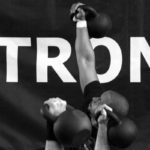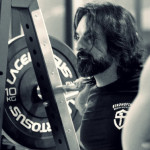One way for me to connect with my athletes is to continue to be an athlete. In addition to playing for the love of the game, two-hand rough football forces me to plan my own programming year round.
The yearly program is broken up into off-season, pre-season, in-season, and recovery cycles. The in-season training cycle is one of the hardest to program, and continuing to play gives me great feedback with respect to what is the right training volume at that time. In general, the challenge with this particular program is training to stay strong and mobile throughout the season, but not doing too much and overtraining the athlete (burning out their nervous system).
This program is not just for football players; it is also great for weekend warriors who love to powerlift. It becomes hard to juggle both and stay healthy, but this program will allow you to maintain your strength and seamlessly pick up where you left off when the season concludes.
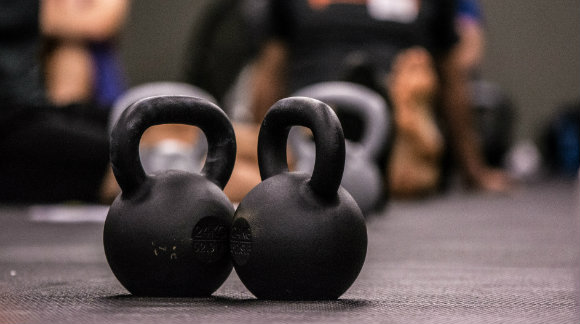 The Challenges of Two-Hand Rough Football
The Challenges of Two-Hand Rough Football
To write a good in-season program, you must know the demands of the sport at play. Although two-hand rough football is not tackle or rugby, I find it to be one of the most demanding recreational sports.
For starters, everyone usually plays receiver and most guys play both ways. This leads to a lot of sprinting, deceleration, and reacceleration. Each play takes about five to seven seconds with thirty seconds of rest between plays, which rely heavily on the creatine-phosphagen system. In other words, a large amount of power is needed to be produced by the muscles, creating a high demand for ATP.
It’s also a physical activity and being strong will improve your performance. It will help you hold on to the catch when you get hit, and help jar the ball away when you hit your opponent. Being 6’2 and having good speed, I run predominantly long routes (sprinting twenty-plus yards) and have to cover a lot of ground on defense. This demands precise programming to play at an explosive level week in and week out.
Utilizing the Strength of Plan Strong
Over the last few years, I have been toying with my in-season programming. For the most part, I felt good, but sporadically my legs would feel heavy. This year, I put a lot of thought into my in-season training. I wanted a program that wouldn’t have me estimating how I would feel on Sundays.
A big influence on my program design was the StrongFirst methodology and their Plan Strong seminar I attended last March. The Strong First methodology is based on Russian weightlifting programs of the 1970s and ‘80s. Not only do those athletes have records that still stand today, but they were also known for their longevity. It’s not that uncommon to hear of a Russian lifter strong like an ox well into his sixties. This is due to their elite programming.
StrongFirst programming is also based on training tactical units. These units need to be strong but also fresh daily. Feeling overly sore or fatigued can lead to their demise. In-season training should be treated the same way. A pulled hamstring will ruin your season.
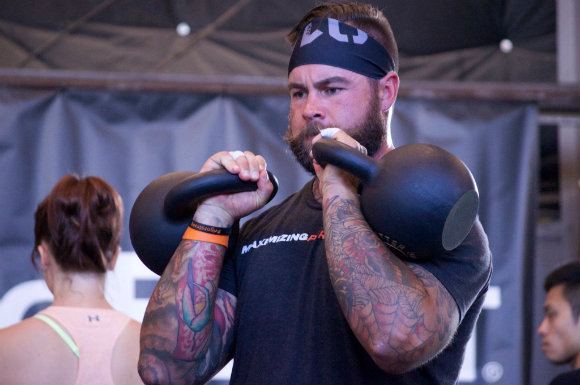 How the In-Season Football Training Program Works
How the In-Season Football Training Program Works
The program calls for three weight workouts a week. Tuesdays are medium, Thursday are heavy, Saturday is light, and Sunday is game day. The medium, heavy, and light days signify a change in the amount of repetitions; however, the weight stays at 72.5% of my one rep-max. The medium day is 3 reps, the heavy day is 5, and the light day 1 to 2 reps.
This set-up allowed my body to recover from the previous game and be fresh for the upcoming game. I also did mobility work and stretching on Monday, Wednesday, and Friday.
Exercise Selection
The Big 5 movement patterns: I pair deadlifts and bench, squats and one-arm presses, and then do pull-ups later in the day.
- Deadlift: Other than being the king of lifts, the lack of deceleration makes this a perfect choice for my main lower-body lift. The eccentric portion of the lift produces muscle tearing and soreness. This not a bad thing, just something we want to minimize during the season. 72.5% of Max (500) = 365
- Bench Press: Main upper-body lift. 72.5% of Max (390) = 295
- Kettlebell Squats: I want to maintain the squat pattern without too much load (deceleration). Squatting with a pair of 36kg bells challenges my body (feels like 275) without having to load up. It is also a great anterior core exercise. More often than not, I find myself putting the squats before the deadlifts. This opens up the hips and gives me better pop on my deadlifts. I also have to clean the bells to the rack position. Nothing simulates taking a hit like a heavy kettlebell clean—you will never shy away from contact again.
- One-arm Kettlebell Press: I do this press to challenge my anti-rotational component and because I love it. 72.5% = 36kg
- Tactical Pull-up: To counteract the pressing. 72.5%= 36kg.
Prior to Starting This Program
I start tempo runs six weeks before the season. In this time, I also finish up my off-season strength program. The tempo runs progressively get my body ready for the repeated sprints I have to endure in the game. (I run short 10- or 15-yard hill sprints most of the year.) Tempo runs should be performed at 75% intensity.
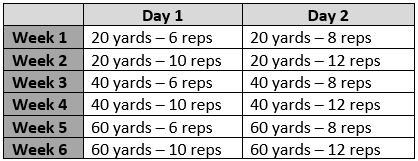 As far as the off-season weight program? This could be an article in itself, so I will keep it brief. I wave between loads of 60% and 92% and use kettlebell swings and snatches for conditioning.
As far as the off-season weight program? This could be an article in itself, so I will keep it brief. I wave between loads of 60% and 92% and use kettlebell swings and snatches for conditioning.
The In-Season Football Program
2 Weeks Before the Season – I started the in-season program two weeks before the season and four weeks into the tempo runs. I wanted to give my body time to acclimate to the new program before playing in the games.
Week 2 of the Season – In the previous years, I always felt great in week one and heavy in week two. I think this was due to the fact that you play at such high speeds in the game and it takes time for your body to adjust and recover. I’ve noticed this is the week most guys get hurt or banged up. This year, I felt really good in week two and it was because of this new program.
Week 3 of the Season – I was feeling strong and fresh daily, almost too easily. The week before StrongFirst published SFG II Derek Miller’s Daily Dose Deadlift Plan, and I found a lot of similarities to the program I was running but with a wave load every seven days.
Derek would have the deadlift at 75% for six straight lifting days and then up percentage of a max to 80%. He would then go back to six days at 75% and on the seventh day go up to 85%. Then, drop back down to 75% and then up to 90%. He would then repeat the cycle, but starting at 82% instead of 80%. This gave me an idea of how to refine my program.
I don’t like to make changes to a program on the fly, but based on how I felt, I thought an increase in intensity every other Thursday wouldn’t be too much. It would also keep my central nervous system dialed in, as it wouldn’t be months without lifting over 80%.
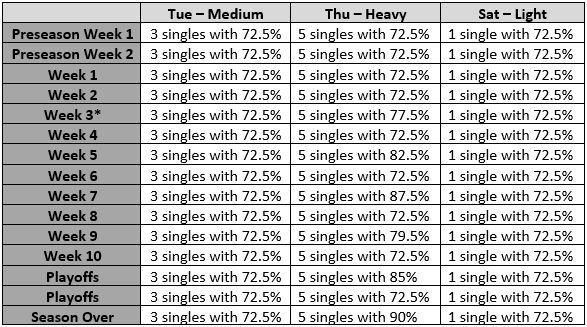 *By week 3, my body acclimated to all the running and I began to wave the loads. You can reduce your heavy day to 2 to 3 reps during the playoffs and championship. We failed to make championship so I lifted at 90%. If we made it, I would have done 2 singles with 80% instead.
*By week 3, my body acclimated to all the running and I began to wave the loads. You can reduce your heavy day to 2 to 3 reps during the playoffs and championship. We failed to make championship so I lifted at 90%. If we made it, I would have done 2 singles with 80% instead.
Conclusion
I felt great all season and this will be my go-to in-season program for years to come. If you’re a football player, a weekend warrior who powerlifts, or an advocate of high-demand recreational sports, try this program and let me know how it goes.
